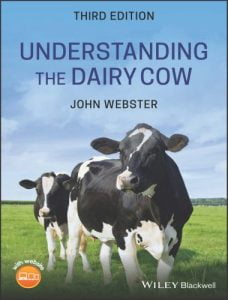Understanding the Dairy Cow 3rd Edition
by John Webster
The mediaeval expression ‘milch cow’ is, in modern parlance, variously used to describe a cow kept for milk
 production and an everlasting source of easy money. It is not hard to see how this second definition has come about. Since the earliest days of agriculture, the cow has served humankind as a regular, reliable source of excel-lent sustenance, in many different physical and social environments and from almost any mixture of feeds that we can provide or that she can forage for herself. Her value comes from her infinite ability to adapt. At the time when the first edition of ‘Understanding the Dairy Cow’ (UDC) was published in 1987, most dairy farmers in the UK fed their cows largely from pasture and other home‐grown crops, the milk lorry took it away and regular cheques arrived in the post.
production and an everlasting source of easy money. It is not hard to see how this second definition has come about. Since the earliest days of agriculture, the cow has served humankind as a regular, reliable source of excel-lent sustenance, in many different physical and social environments and from almost any mixture of feeds that we can provide or that she can forage for herself. Her value comes from her infinite ability to adapt. At the time when the first edition of ‘Understanding the Dairy Cow’ (UDC) was published in 1987, most dairy farmers in the UK fed their cows largely from pasture and other home‐grown crops, the milk lorry took it away and regular cheques arrived in the post.
It was all so simple. The subsequent 30+ years have witnessed a roller‐coaster ride of change. The imposition then removal of quotas on milk production. The explosive increases in individual cow yields, achieved by a combination of genetic selection and radical changes in nutrition. Our greater concern about the environmental impact of farming in general and ruminants in particular. Our greater concern, expressed through our buying habits, about farm animal welfare and the potential risks attached to the consumption of food from animals.
The circumstances in which the dairy cow may find herself are many and varied but a cow is still a cow. For this reason UDC, in its successive editions, has never taken the form of an instruction manual on dairy cow management but an examination of the fundamental principles of physiology, health and behaviour that govern both her capacity to produce milk and also give proper attention to her welfare in all circumstances; intensive or extensive, high‐tech or organic.
Download: Principles of Dairy Chemistry
This Understanding the Dairy Cow 3rd Edition is, in effect, is a complete rewrite with over half the material radically updated or entirely new. It reflects the major shift in dairy production away from family farms with 100 cows or less, each producing modest amounts of milk largely from their own resources, to very large production units, with perhaps 1000 cows, housed throughout lactation, producing very large quantities of milk (and excrement) from feed tractored to them from near and far. It considers in detail the impact of these changes on cow health and welfare, and their environmental impact in terms of methane production and nitrogen pollution.
It also acknowledges that dairy farmers can no longer operate on the simplistic assumption that while they continue to produce milk, the people will continue to buy it. Consumers and retailers now demand quality assurance as to production standards with regard to environmental quality, sustainability and animal welfare. All these things receive my attention.
-
- Book Name: Understanding the Dairy Cow 3rd Edition
- File Type: PDF
- Download: Link
- Size: 9 MB
- Password: PDFLibrary.Net
